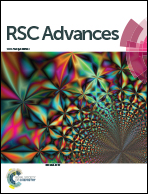Green preparation of nitrogen doped carbon quantum dot films as fluorescent probes
Abstract
To prepare nitrogen doped carbon dots (NCDs) with excellent luminescence efficiency, a facile hydrothermal method was developed using cabbage juice as the carbon source and poly ethylene polyamine (PP) as the nitrogen source. Then, as-prepared NCDs were grafted onto calcium alginate to produce calcium alginate film (CA-NCDs), and the CA-NCDs were used as a fluorescent probe. The significant quenching effect of Fe3+ was established. The ratio of fluorescence intensity (F/F0) of the CA-NCDs had a linear relationship with the concentration of Fe3+ within the range of 0 to 48 μM (R2 was 0.9947) and the detection limit was 1.4 nM. In addition, the recovery of spiked samples ranged from 98.6% to 103.1%. Most importantly, the amino-functionalized CA-NCD fluorescent probe can be successfully applied for the detection of trace Fe3+ in water samples.



 Please wait while we load your content...
Please wait while we load your content...